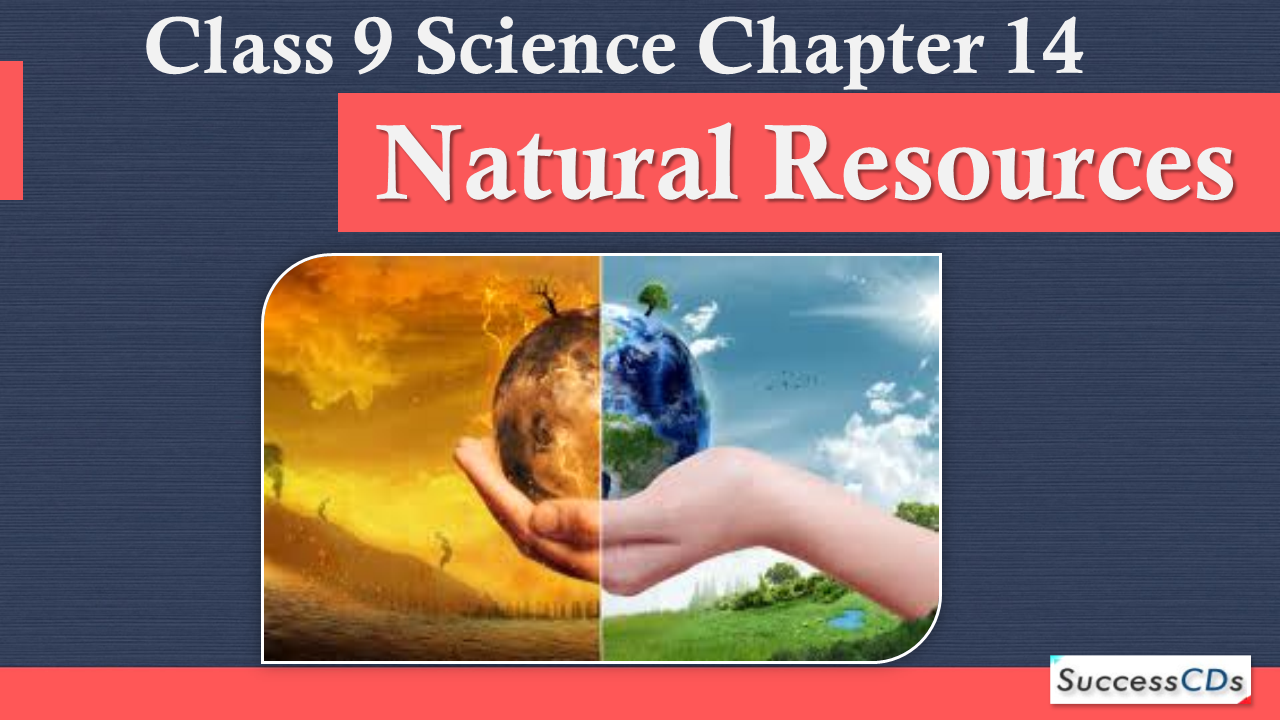CBSE Class 9 Science Chapter 14 Natural Resources Notes, Explanation with Video and Question Answers
Class 9 Science Chapter 14 – Natural Resources
Topics to be covered
- See Video Explanation Chapter 14 – Natural resources
- Biosphere and its components
- Types of natural resources
- Air and Air pollution
- Ozone and ozone depletion
- Water
- Water harvesting
- Water pollution
- Eutrophication
- Biological magnification
- Soil
- soil erosion
- Biogeochemical cycles
- Water cycle
- Oxygen cycle
- Nitrogen cycle
- Carbon cycle
- NCERT Book solutions
We know that everything that surrounds us is called the environment. It acts as a life-supporting unit. It provides us everything- food, water, air, etc. that is important to us for our survival. Let us study about it and its components.
Natural Resources Class 9 Video Explanation
Click Here for Natural Resources MCQs
Biosphere and its components
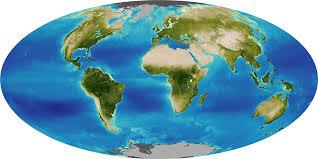
Do you know that what is the region of the earth’s crust where life exists called? It is Biosphere. Let us study about it.
It is the unit that comprises of the earth’s crust and the atmosphere in which we live. It can be basically divided into three layers:
- Atmosphere
- Hydrosphere
- Lithosphere
Lithosphere is the outer solid crust of earth called as land, hydrosphere is the water component of earth and Atmosphere is the protective blanket that surrounds us.
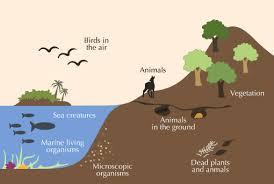
The two components of the Biosphere are:
- Biotic component
- Abiotic component
Abiotic component- That is all non living factors that surround us which includes climatic factors, topographic factors, water bodies, etc.
Biotic factors- It includes all living forms.
Please note: Both abiotic and biotic factors interact to meet the basic needs of life forms.
Top
Types of natural resources
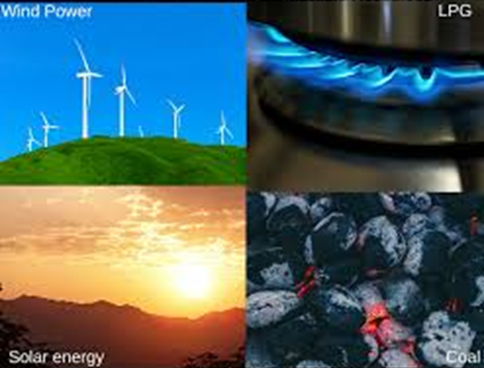
Natural resources are actually living and non living components of nature which are used by us to fulfill our needs. They are also called as earth resources as they are found on the earth. Let us study about their different types.
- Exhaustible
- In-exhaustible
In Exhaustible resources
The resources that occur in such abundance that they are not likely to get exhausted despite continuous use. Like Sun, water, air, etc.
Exhaustible resources
The resources that are available in limited quantity and get depleted if wise use is not done. Example: fossil fuels, etc.
Top
Air and Air pollution
We know, if we look at the Sun, we have many layers of gaseous envelopes between us. These gaseous envelopes allow the light to reach us, affect climate and contain many essential elements.
The gaseous envelope that surrounds us is called atmosphere.
Atmosphere is divided into five layers:
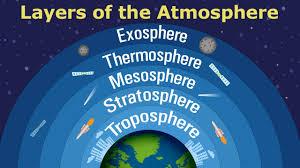
- Troposphere
- Stratosphere
- Mesosphere
- Thermosphere
- Exosphere
Troposphere
It is the lowest region of the atmosphere which contains air. It extends from 8 to 20km. Mostly all climatic events like thunder, storm, etc. occur in this region only.
Air: It is a mixture of gases such as:
- Nitrogen 78%.
- Oxygen 21%.
- Carbon dioxide 0.03%.
- Water vapour.
- Suspended dust particles.
- Gases like methane, etc. in traces.
Importance of atmosphere
- It helps in climatic control.
- Atmosphere helps in keeping the temperature steady during the night and day.
- It causes wind to blow that is land breeze and sea breeze.
- It causes rain.
Land breeze
During the day time land gets heated faster than water. The air closer to the land gets heated and rises up.
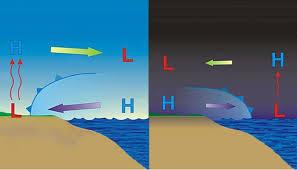
This creates a low pressure in the area. But in the case of sea, it doesn’t get heated up so readily. Due to this, the pressure in that region increases and it starts moving towards land to fill the space. This is called Land breeze.
Sea Breeze
During the night, water loses heat much faster than land. Therefore, the air above the sea gets heated and rises up, creating low pressure.
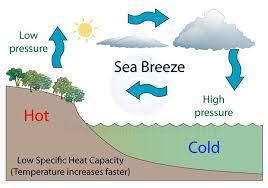
To fill that space, the air from land moves towards sea due to increased pressure.
Air pollution

The contamination of air with unwanted and undesirable substances is called air pollution.
Causes
- Natural causes like forest fires, dust storms, etc.
- Man made causes like :
- Burning of fossil fuels.
- Gaseous emission from industries, vehicles, etc.
- Particulate pollutants like SPM ( is smoke, soot, etc.).
- Fly ash and dust.
- Gases like sulphur dioxide and nitrogen dioxide, Carbon monoxides.
Effects of air pollution
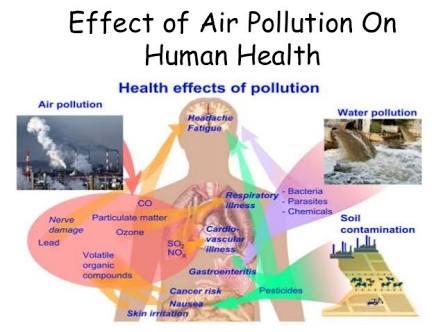
- SPM causes asthma, bronchitis, allergic cold.
- Pollutant gases cause irritation in eyes, throat and lungs. They injure lungs, kidneys, spleen, cause heart related diseases, etc.
- Hydrocarbon vapours causes cancer.
- It affects plants also like falling of leaves, reduced growth, degeneration of chlorophyll, etc.
- It leads to acid rain.
- It causes global warming.
- It causes depletion of the ozone layer.
Ozone and ozone depletion

Ozone is a molecule of three oxygen atoms i.e. O₃. This is present in the stratosphere that is a layer of the atmosphere. Ozone Is formed when u-v rays in upper atmosphere split oxygen atoms and then the oxygen atom combines with oxygen molecule to form ozone.
Ozone protects us from ultraviolet radiations as it doesn’t allow them to enter the earth’s atmosphere. If they enter the earth’s atmosphere, they may harm us in many ways such as:
- They may raise the temperature of the earth.
- It can cause global warming.
- It may cause skin disorders.
- It can cause eye disorders and many more.
Ozone depletion
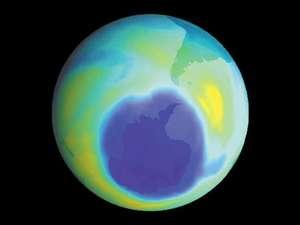
There are certain harmful substances that affect the ozone. Mostly, the vapours of these substances move to the upper atmosphere, react with ozone causing its dissociation. When dissociated, the ozone molecule breaks into oxygen atoms and oxygen molecules. This leads to its depletion.
The thinning of the ozone layer by air pollutants is called ozone depletion. For this, some synthetic chemicals are responsible like Chloro Fluoro Carbons that are used in refrigerators, air conditioners, etc.
There are certain measures that are taken to protect this layer like emphasizing the use of alternatives of these substances and freezing the use of harmful substances that cause thinning.
Top
Water
We know that the hydrosphere layer consists of water component which is an inexhaustible resource. Water usually exists as a liquid above zero degree Celsius and below 100 degree Celsius. There are different types of water available like surface water, runoff water, ground water, etc. But out of all, only capillary water is available to plants. Let us study about it.
All water bodies like oceans, rivers, lakes, etc. constitute the hydrosphere. Hydrosphere comprises of water that is an inexhaustible resource.
Top
Water harvesting
It is capturing, collection and storage of rainwater and surface run off for filling either small bodies or recharging ground water.
Benefits
- It ensures water availability.
- It reduces the chances of flooding during the rainy season.
- The groundwater is regularly recharged.
Khadian system
It is a traditional rainwater harvesting for agriculture practised in Rajasthan. It consists of very long earthen embankment down the slope of catchment areas which helps in retaining run off water.
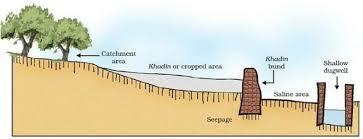
A shallow well is often dug behind the embankment to store extra overflow water. The stored water slowly percolates down into the ground. The area is then used for growing crops and for vegetation .
Advantage of watershed management
(a)Growing more trees in watershed areas increases the retention of more rain water and protection of soil from erosion.
(b)It enhances the productivity and increases the income of watershed community.
(c) it reduces draughts and floods.
(d)It increases the life of downstream dams and reservoirs because of less silting.
Top
Water pollution

The contamination of water bodies with harmful and undesirable substances is called water pollution.
Water pollutants
- Physical water pollutants : like heat and oil spills.
- Chemical pollutants like detergents, fertilizers, pesticides, etc.
- Biological pollutants like viruses, bacteria, etc.
Sources of water pollution
- Sewage.
- Industrial waste.
- Soaps, detergents .
- Petroleum oil, etc.
Harmful effects of water pollution
- It causes human diseases like typhoid, cholera, Jaundice, etc.
- It leads to ecological imbalance.
- It causes water bloom leading to eutrophication.
- It causes a change in temperature.
- It leads to biological magnification.
- It causes decomposition of organic matter.
Eutrophication
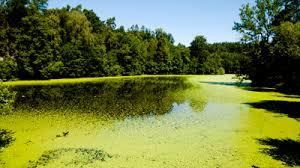
The excess disposal of chemicals in water bodies leads to excess growth of algae in water bodies that take up the dissolved oxygen of water due to which aquatic life starts disappearing. This is called eutrophication.
Top
Biological magnification
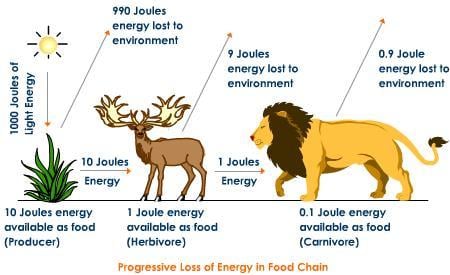
It is defined as an increase in the concentration of some harmful substances at trophic levels. Sometimes some harmful chemicals may enter into the food chain. It is surprising to note that at each step, the concentration does not decrease like energy, rather it keeps on increasing at each level and the maximum sufferer is the last organism. Like in the given figure, the maximum sufferer is the lion.
Top
Soil
It is the part of earth that consists of degraded rock and decaying organic matter.
Formation of soil
We have seen soil many times. But do you know what exactly it is and how it is formed. It is actually a portion of earth’s surface consisting of disintegrated rocks and organic matter. Plants grow in soil and their growth is affected by the fertility of soil. Also, the soil acts as a home for various organisms. Let us study more about it and its formation.
Soil is formed by the process of weathering of rocks.

In this process, the bigger rocks break up into smaller rocks and finally, into such smaller parts that it forms soil. The factors that are responsible for weathering are: Physical factors like temperature, wind, rain, water, etc. The water seeps inside the rocks and that causes cracks in rocks. Biological factors like lichens, etc. grown on rocks, secrete certain acids that degrade by penetrating into rocks through their roots. These cracks cause weathering of rocks.
Soil profile
If we take the soil in our hands and observe the substances and particles present in it, we can clearly make out that it consists of different sized particles. Let us see the types.
Soil profile: It is the different types of layers that make soil.
The soil is divided into different layers:
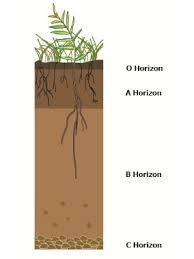
By looking at the figure we can see the difference in the composition,Size and type of particles in soil . That is the reason it is divided into different regions.
- A horizon: it is the top soil that is rich in humus. The roots of plants are embedded in this layer.
- B-horizon : this layer is composed of minerals.
- C-horizon : this layer consist of unconsolidated parent material.
- D- horizon: it consist of rocks.
Composition of soil
The soil consists of four types of rock particles which differ in size, looks and texture. It consists of gravel, sand particles, silt particles and clay particles.
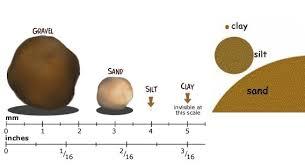
- Gravel: these are larger particles which can be picked up by hand. Particle size of gravel is greater than 2mm in diameter.
- Sand particles: they are coarse to touch and have a particle size ranging from 0.05mm to 2,00mm. They can be seen with naked eyes.
- Silt particles : These soil particles have particle size between 0.005 to 0.05mm.
- Clay particles: These are the smallest soil particles with size less than 0.005mm.
Types of soil
Sandy soil
This soil contains a large amount of sand particles and a small amount of silt and clay. It cannot hold much water.
Clayey soil
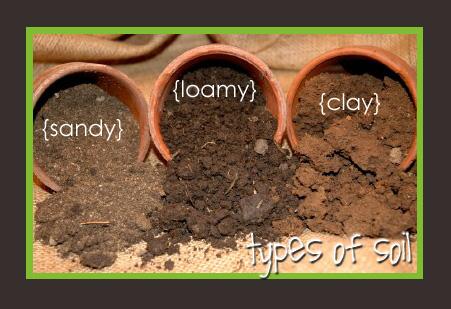
The soil contains clay particles and a small quantity of humus and silt. It can hold water but cannot trap air.
Loamy soil
It contains silt, sand and humus. It has good water holding capacity and also allows aeration of roots.
Top
Soil erosion
It is the removal of the top layer of soil by wind, water, etc.
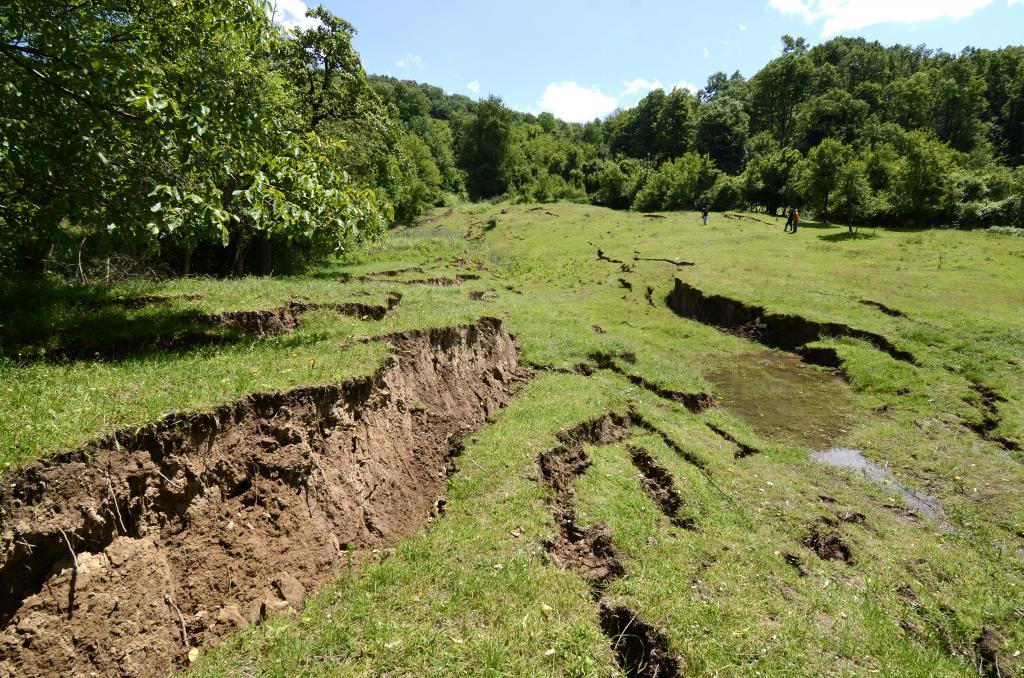
Causes of soil erosion
- Winds
- Heavy rains
- Improper farming
- Human actions like expansion of urban sector, etc.
- Dust storms
- Frequent floods
Effects of soil erosion
- Loss of fertile soil
- Landslides
- Floods
- Silting of water reservoirs
Prevention of soil erosion
- Terrace farming
- Wind breaks
- Proper drainage canals around fields
- Making strong embankments along river banks
Biogeochemical cycles
We have already discussed that the biotic and abiotic components interact with each other and as a result they form a stable system. Their interactions result in the transfer of energy and matter between different components of the biosphere. As a result, the nutrients are added to the soil when the organisms die and then, through the same cycle, these nutrients are picked up by different organisms through different modes and then again added to the soil. So, in that way, the composition of the nutrient pool is maintained.
It is the recycling of nutrients (from nutrient pool) through living and non living components of the biosphere.
Let us study different nutrient biogeochemical cycles :
Top
Water cycle

When the Sun rays falls on the earth, the water from water bodies gets evaporated. The vapours formed, rise up in the atmosphere,where they condense to form clouds. When the cloud becomes big enough, then precipitation occurs and water moves back to earth in the form of rain. So, we can say that water vapour mainly consists of the processes of evaporation, condensation and precipitation.
Top
Oxygen cycle
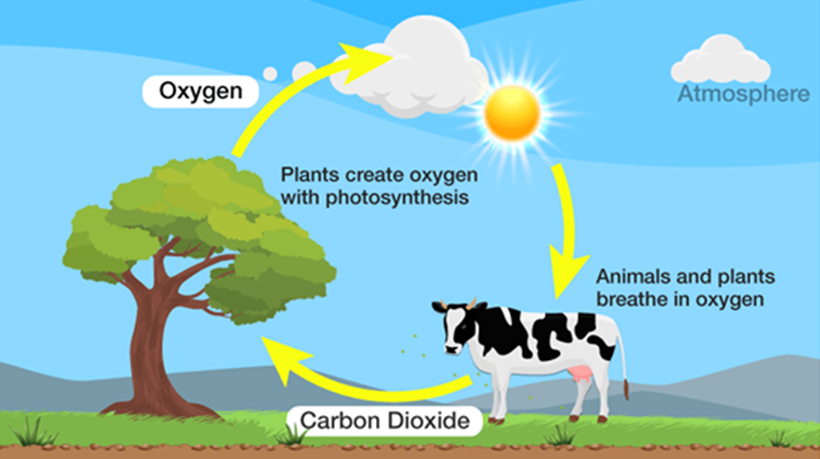
The plants carry out photosynthesis in the presence of sunlight and release oxygen as bi- product. This oxygen is taken up by animals for breathing and they release carbon dioxide. Again this carbon dioxide is picked by plants and the cycle repeats.
Top
Nitrogen cycle
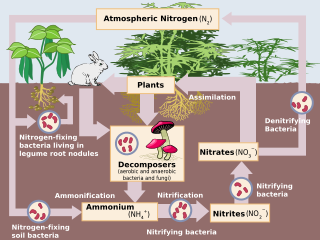
The atmospheric nitrogen is fixed by nitrogen fixing bacteria like rhizobium which is present in the root nodules of leguminous plants (nitrogen fixation).
This nitrogen is first converted into ammonia by bacteria (ammonification) and then to nitrites and nitrates by bacteria nitrosomonas and nitrobacter (nitrification). Then these nitrates are further converted into free atmospheric nitrogen by bacteria like pseudomonas (de-nitrification).
Further, the other source is that this nitrogen, through soil is taken by plants, which are further eaten by animals. The animals’ excretory product is urine that has ammonia which again can be changed to nitrites, nitrates and back to atmospheric nitrogen.
Top
Carbon cycle
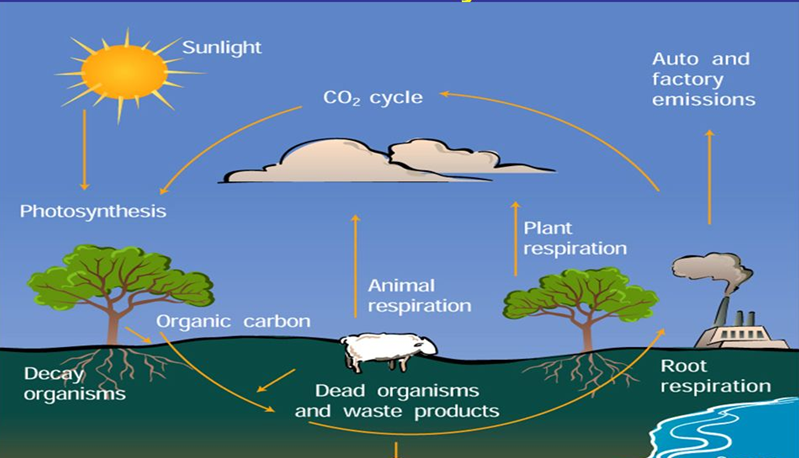
The carbon in the atmosphere exists as carbon dioxide. This gas is taken by plants for photosynthesis. The plants are eaten up by animals. The animals respire and they release carbon dioxide. Also, the factory emissions and vehicle exhausts consist of carbon dioxide which is further released in air and hence, its value is maintained.
Top
Natural Resources Class 9 Question Answers
Q1. How is our atmosphere different from atmosphere on Venus and Mars?
Ans. Differences between atmosphere over earth and atmosphere over Venus and Mars
| Atmosphere over earth |
Atmosphere over Venus and Mars |
| 1. It contains nitrogen and oxygen. 2. CO2 content is low (0.03%). 3. Water vapours present. 4. Living beings maintain composition of atmosphere. |
1. Both are absent. 2. CO2 is major component 95-75%. 3. Water vapours absent. 4. Living beings are absent and play no role. |
Q2.How does atmosphere act as a blanket?
Ans. Atmosphere acts as a blanket because of following reasons:
1. Air is a bad conductor of heat.
2. The atmosphere keeps the average temperature of earth fairly steady during the day and even during the course of the whole year.
3. The atmosphere prevents the sudden increase or decrease in temperature.
Q3. What causes winds?
Ans: All movements of air are caused by the uneven heating of the atmosphere in different regions of earth. Air above the land gets heated faster and being light, starts rising. As the air rises, a region of low pressure is created. Due to this, the air over the sea moves into this area of pressure.
Factors which control movement of wind
1. The rotation of earth and presence of mountain ranges are order factors which cause winds.
2. Uneven heating of land in different parts of earth.
3. Differences in heating and cooling of land and water.
Q4. How are clouds formed?
Ans. Clouds are formed by the condensation of water droplets in the air. It occurs as large amount of water evaporates and goes into the air. Air rises up, it expands and cools. The cooling causes the water vapour in the air to condense in the form of tiny droplets. These water droplets get bigger and form clouds.
Q5. List any three human activities that you think should lead to air pollution.
Ans. 1. Combustion of fossil fuels.
2. Industrial pollutants.
3. Release of radioactive substances by nuclear explosions.
Q6. Why do organisms need water?
Ans: Organisms need water for the following reasons-
- All cellular processes take place in water medium.
- Water is the universal solvent. All reactions that take place within our body and within the cells occur between substances that are dissolved in water.
- Substances are also transported from one part of the body to the other in a dissolved form.
- The availability of water is the major resource which determines the diversity of life on land.
- Water is required by organisms for many activities such as agriculture.
Thus, water is essential for maintenance and very existence of life.
Q7. What is the major source of freshwater in the city/town/village where you live?
Ans. The sources of freshwater are as follows-
- Fresh water is found in ice-caps and on snow covered mountains.
- The underground water and the water in rivers, lakes and ponds is also fresh.
- This water is available for human use. Underground water in rivers, tanks and ponds are available for human use.
Q8. Do you know any activity which may be polluting the water sources?
Ans. Activities which pollute water sources are as follows-
- Sewage from towns and cities and waste from factories released into water bodies.
- Discharging hot water from cooling towers into water bodies affect living organisms.
Q9. How is soil formed?
Ans: The breaking up of rocks at or near the surface of the earth over long periods of time result in soil formation. They are broken down by various physical, chemical and biological processes. The end products of this breaking down are the fine particles of soil. There are many other factors which play a vital role in the formation of soil. These factors are :
(1) The Sun – It causes heating of rocks which causes cracking and ultimately breaking up into smaller pieces.
(2) Water – It breaks rocks both by freezing and fast flow.
(3) Wind – It causes erosion of rocks.
(4) Living organisms – Lichens and mosses growing on rock surface form cracks in them and result in their breakdown.
Q10. What is soil erosion?
Ans. Soil erosion – Removal of useful components from the soil which affects the fertility of soil is called soil erosion.
Q11. What are the methods of preventing or reducing soil erosion?
Ans. Prevention of Soil erosion
1. It can be prevented by intensive cropping.
2. It can be prevented by providing proper drainage canals around the fields.
3. Soil erosion in hilly areas can be prevented by practicing terrace farming.
4. It can be prevented by planting trees and sowing grasses.
5. It can be prevented by constructing strong embankments along the river banks.
Q12. What are the different states in which water is found during water cycle?
Ans. Water is found in gaseous state, liquid state and solid state during water cycle. Ground water, surface water, water vapours, water droplets, clouds.
Q13. Name two biologically important compounds that contain both oxygen and nitrogen.
Ans. Proteins and nucleic acids (DNA and RNA)
Q14. List any three human activities which would lead to an increase in CO2 of air.
Ans: Three human activities which would lead to an increase in CO2 of air are as follows-
- Industries due to burning of fuel and combustion of fossil fuels to provide energy for various needs like heating, cooking, transportation, etc.
- Respiration.
- Deforestation.
Q15. What is greenhouse effect?
Ans. Greenhouse Effect – The increase in global temperature due to rise in CO2 is called the Greenhouse effect. It causes global warming.
Q16. What are two forms of oxygen found in the atmosphere?
Ans.1. Oxygen is about 21% in the air.
2. In the upper region such as stratosphere oxygen is found in the form of ozone.
Q17. Why is atmosphere essential for life?
Ans: Atmosphere is essential for life because of the following reasons-
- It acts as a protective blanket.
- It causes winds.
- Rain and rainfall patterns are decided by winds.
- Air provide us oxygen to breathe.
- Atmosphere absorbs ultraviolet rays that protects living organisms.
Q18 Why is water essential for us?
Ans:
- Water makes 60-70% of our body weight.
- All the reactions take place in our body and within the cells occur between substances that are dissolved in water.
- It is required for the transport of materials.
- It is a universal solvent.
Q19. How are living organisms dependent on soil?
Ans: Living organisms are dependent on soil due to the following reasons-
- It plays an important role in plant growth by providing nutrients, water, etc.
- It supports the growth of crops, forests and grasslands.
- Soil is an important resource and decides the diversity of life in an area.
Q20. Write the role how forests influence the quality of air, soil and water resources?
Ans:
- They have moderate effects on climate.
- They prevent floods.
- They release oxygen in the atmosphere during photosynthesis.
- The forests help in increasing the amount and periodicity of rainfall.
- It plays an important role in preventing pollution.
Class 9 Science Chapter-wise Explanation
